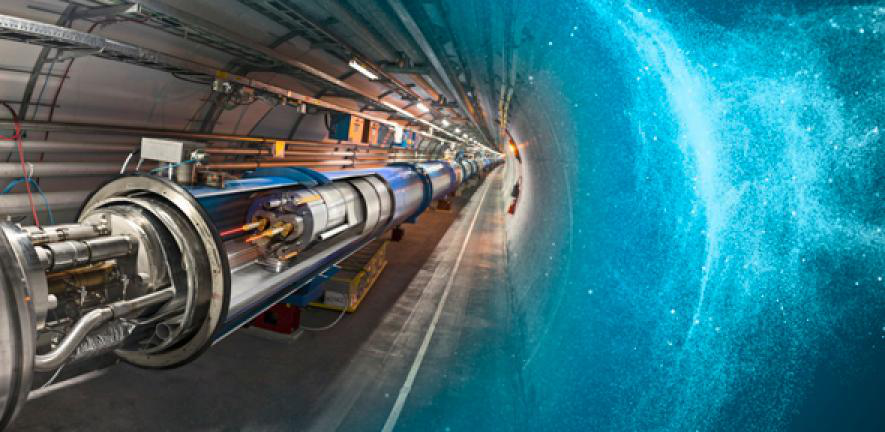Conveners
Parallel Session II: Theory
- Abdesslam Arhrib (Université Abdelmalek Essaadi, FSTT, B. 416, Tangier, Morocco)
- Abdelilah Moussa (University Mohamed I Oujda)
Big science is characterized by long term multi-lateral engagements and large scale instruments that are used to address fundamental questions in science. The projects in big science work require huge funding and extensive collaborations at the regional and international levels. Experiences elsewhere, for example in Europe and the Middle East, have shown that in addition to technological...
This work focuses on the controversial debate that has arisen over the last two decades about the possibility that the electromagnetic field affects the lifetime or decay width of an unstable particle. In this presentation, we highlight the possible effect of the electromagnetic field on the decay of particles through the theoretical study of some decay processes such as those of the pi (pion)...
In this work, we have theoretically studied the neutral Higgs pair production in Two Higgs Doublet Model (THDM) in the presence of a circularly polarized laser field. The laser-assisted differential partial cross section is derived in the centre of mass frame at the leading order including Z diagram. The total cross section is computed numerically by integrating the differential cross section...
In view of the great contribution of neutrino-electron scattering to the deep understanding of
electroweak interactions, we focus in this paper on the study of elastic scattering of a muon neutrino
by an electron (e − ν μ → e − ν μ ) in the presence of a circularly polarized electromagnetic field. We perform our theoretical calculation within the framework of Fermi theory using the exact...
The main quest of modern physics is to describe all four elementary interactions within the same framework. Our inability to incorporate gravity as a renormalizable quantum field theory is a major motivation for a physics beyond the standard model, the most amazing progress we have made to understand quantum gravity is through local supersymmetry theory: supergravity. ...
We explicitly test the asymptotic grand unification of a minimal 5-dimensional model with SO(10) gauge theory compactified on an $S^{1}/Z_{2}\times Z^{\prime}_{2}$ orbifold. We consider that all the matter fields propagate in the bulk and show that the gauge couplings asymptotically run to a unified fixed point in the UV. However, the Yukawa couplings will typically hit a Landau pole before...
We introduce some basic definitions and concepts of tensor network. We show that the tensor network can be used to represent quantum many-body states, where we explain MPS(Matrix Product States) in 1D and PEPS (Projected Entangled Pair States) in 2D systems, as well as the generalizations to thermal states and operators. The quantum entanglement properties of the tensor network states...
We present a new chiral gauge anomaly flipped 341 model where lepton families are arranged in different SU(4) gauge group representations leading to a nonuniversal coupling with heavy neutral gauge bosons $Z^{\prime}$ and $Z^{\prime\prime}$ of the model. The resulted flavor-changing neutral current in the leptonic sector is discussed and bounds on some of the flavor changing parameters are...
The major problems in particle physics is the origin of the flavour structure of the quarks, leptons and the generation number, mass hierarchy and mixing angles. One of the candidates for the origin of flavour structure may be in higher dimensional theories such as superstrings; certain compactifications of superstrings, lead to non-abelian discrete flavour symmetries. In this contribution, we...
In the pure scattering theory, the universality of the soft limit has been studied for a long time. In this talk we review the property of soft limit to relate an n-point amplitude to an (n-1)-point amplitude. We show how this property can be used to decompose amplitudes into different complementary soft channel. The existence of such decomposition provides a new way to understand how to...
Motivated by the recent LHCb-group discovery of an exotic hadron at 3878 MeV interpreted as $J^P = 1^+$
$T_{cc}$ tetraquark state , we improve in this work the existing results from QCD Spectral Sum Rules (QSSR)
at lowest order (LO) by combining the mass determinations from the ratio R of Inverse Laplace sum rules
(LSR) with the double ratio of sum rules (DRSR). In so doing, we start by...
The quantum algebra of observables of particles in homogeneous space from bicrossed product model $ \mathcal{C}[x]\blacktriangleright\joinrel\mathrel{\triangleleft}\mathcal{C}[p] $ forms a Hopf algebra $ A(+,\mu,\eta,\Delta,\epsilon) $. Quantum mechanic is formulated algebraically while gravity is more geometric. Quantum geometry which is a non commutative geometry, with Hopf algebra give us...
Previously an equation of state for the relativistic hydrodynamics encountered in heavy-ion collisions at the LHC has been calculated using lattice QCD methods. This leads to a prediction of very low viscosity, due to the trace anomaly. Finite system corrections to this trace anomaly could challenge this calculation, since the lattice QCD calculation was preformed in an effectively infinite...

